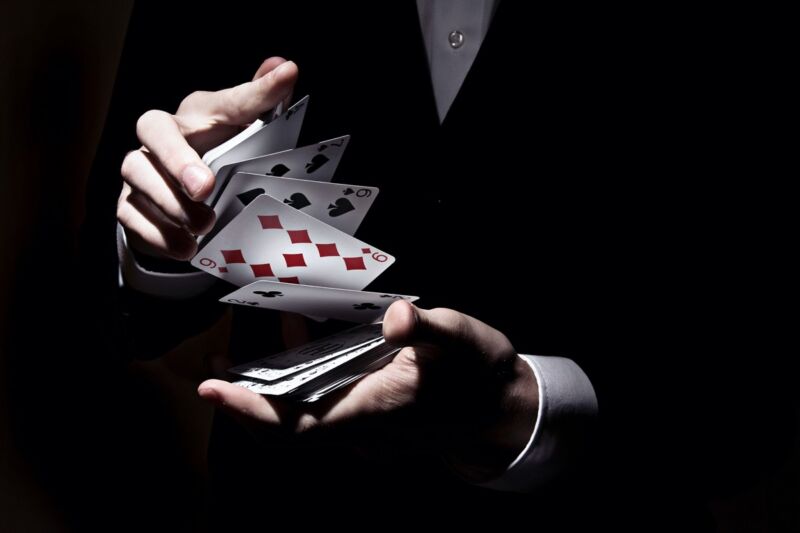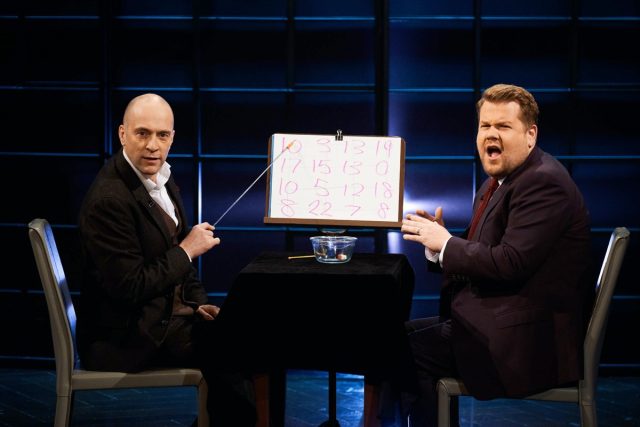
Pick a card, any card. It's a staple of traditional magic tricks. But if you choose the three of diamonds, chances are you may have been "primed" by the magician to pick that card without even being aware of it. That's because certain subtle verbal and gestural cues can unconsciously influence decision-making, according to a recent paper in the Proceedings of the National Academy of Sciences (PNAS).
There is a certain degree of well-founded skepticism surrounding studies of visual or verbal priming. There was, for instance, a famous "experiment" in 1957 by a market researcher named James McDonald Vicary, involving subliminal advertising. Vicary claimed to have conducted an experiment in which some 45,000 people attending screenings of the film Picnic at a Fort Lee, New Jersey, theater were repeatedly shown brief ads ("Drink Coca-cola" or "Hungry? Eat popcorn") lasting just 1/3,000th of a second during the film—thanks to a tachistoscope Vicary said he installed in the projection booth. He reported an 18.1 percent increase in sales of Coca-Cola and a startling 57.8 percent increase in popcorn sales as a result.
The concept of subliminal advertising subsequently spread like wildfire, featuring in a 1973 episode of Columbo and even prompting the CIA to issue a cautionary report. There was just one problem: Vicary was a fraud. Nobody was ever able to reproduce those results—including Vicary himself—and Vicary eventually admitted he had falsified his data, and the story had been a gimmick to prop up his struggling marketing business. It's possible he never even conducted the original experiment.
While more recent, non-fraudulent studies have suggested that priming can influence people's choices, those studies have limitations. For instance, the choices subjects can make are usually limited to two or three options, and the experiments are generally done in a tightly controlled laboratory setting, rather than a more natural real-world environment. But there is substantial anecdotal evidence that the forcing techniques used by magicians are effective; it just hadn't been studied scientifically. And unlike typical free choice paradigms tested in labs, such techniques are subtly integrated into performances.
Alice Pailhès, a psychologist at Goldsmiths University of London and co-author of the PNAS paper, is well aware of the checkered history and longstanding difficulty in replicating social psychology experiments on priming effects. But she feels confident in the use of magicians' techniques in her own work on how unconscious factors can influence choice, since they rely on tightly controlled scripts and actions, while still being embedded in a natural, conversational environment. She started implementing magic tricks while still a graduate student in France. "I love magic, and I quickly realized that magicians are the best to influence choices," she told Ars.

Pailhès found inspiration for her most recent research in British illusionist Derren Brown. Brown uses mental priming and forcing techniques (among other tools) involving verbal and visual cues in his performances—prompting someone, for instance, to think of the three of diamonds card. (Apparently the three of diamonds is an unlikely card for people to randomly choose from a 52-card deck.)
Brown's method involves asking an audience member to attempt to "mentally transmit" the image of a playing card, instructing the spectator to "make the color bright and vivid." This should prompt the spectator to think of a red-suited card, as opposed to a black-suited one. Then Brown asks the audience member to imagine a screen, miming the shape of a diamond with his hands as he does so to prime the spectator to think of the suit of diamonds.
To prime the audience member to think of the number 3, Brown asks them to imagine the "little numbers down in the corner of the card and in the top." As he does so, he rapidly draws threes in the air, as if on an imaginary card, with his index finger. Finally, he asks the spectator to imagine the "things in the middle of the card, the boom, boom, boom, the suits" while pointing to three imaginary symbols in the air. The entire priming exercise lasts just 15 seconds.
Pailhès and her co-author, Gustav Kuhn, recruited 90 volunteers and randomly allocated them to two groups: one group who watched a live performance of the experiment, and one who watched a videotaped version. Pailhès performed the priming herself, using Brown's method to focus on the number of the card she wished the participants to choose (three) and the suit (diamonds). Rather than doing so in the lab, she sat at a table in the Goldsmith cafeteria, facing the subjects, and had them either watch her for instructions, or watch a video of her delivering the same instructions on a laptop with headphones.
Afterward, participants wrote down the card they chose and rated how free and in control they felt about their choice. "Participants' feeling of freedom is one of the key elements of a successful forcing technique," the authors wrote. "If the magician manages to force a card, but this person feels constraint and not free in their choice, the trick no longer work[s]." Those measures also enabled the researchers to assess how aware the participants were of the attempts to manipulate their choice by asking if they had noticed any gestures on the part of the performer.
-
Example of a priming gesture for the suit of diamonds.Alice Pailhès/Gustav Kuhn
-
Example of a priming gesture for the number three.Alice Pailhès/Gustav Kuhn
The authors found that 17.8 percent of the subjects chose the three of diamonds, while 38.9 percent chose a three (among all four suits) and 33.3 percent chose a diamond (among all available cards in that suit). Subjects most commonly chose the three of diamonds, followed by the three of hearts. As a control, the experiment was repeated by having participants watch a video of the same performer (Pailhès) and script, minus any priming gestures. Subjects chose the three of diamonds, or a three, significantly more often with the priming than without, or in a random distribution. Choosing a diamond alone showed no statistically significant difference between priming, no priming, and a random distribution.
Of those subjects (16) who chose the three of diamonds, just three of them reported knowing the reason for their choice. Similarly, only seven of the 35 participants who chose a three card said they knew the reason for their choice—and even then, only three of those seven subjects specifically mentioned the performer's gestures. The others said they chose it randomly, or came up with a confabulation to explain their choice—for instance, "I always seem to count in threes," or because it was their favorite number. "Our results dovetail findings from the choice blindness literature, which illustrates that people often do not know the real reason for their choice," the authors wrote.
"I find it amazing that so many people have no idea I am influencing them with my gestures."
About 72 percent of the subjects noticed at least some of the priming features, but this was independent of whether or not they picked the three of diamonds, and their descriptions of the gestures were vague. Pailhès and Kuhn found that it made no difference whether the priming was done via a live performance or a video, which ran counter to their pre-experiment predictions. Pailhès was also pleasantly surprised that her priming performance actually worked on so many subjects, especially since she is by no means a professional magician or performer. "I find it amazing that so many people have no idea I am influencing them with my gestures," she said.
Granted, a 17.8 percent success rate in getting subjects to choose the three of diamonds doesn't exactly speak to the robustness of the technique—that's why professional magicians rarely rely on priming methods alone. But it is still significantly higher than the percentage of subjects who would randomly choose that card. Brown, according to Pailhès, is likely to have a higher success rate. He's a gifted illusionist with an admitted knack for spotting susceptible people, and he generally performs these kinds of tricks within a reinforcing context of whatever tricks or audience interactions came before.
Understanding the underlying cognitive mechanism—the next step in Pailhès' research—is important because such techniques could be used for more nefarious purposes to influence other mental processes, according to the authors. Prior studies, for instance, have shown that subtle hand gestures and similar priming methods can influence eyewitness testimony and even implant false memories.
"If you witness a crime and then I interrogate you, and I ask which type of jewelry the suspect was wearing, if I'm just touching my finger, there's a high chance you will remember the suspect wore a ring," Pailhès explained. "Even if it was not true. So this could have a big impact in the criminal justice system. If you know that you can be influenced in such a way, maybe you will be more careful."
DOI: PNAS, 2020. 10.1073/pnas.2000682117 (About DOIs).
"choice" - Google News
July 23, 2020 at 06:56PM
https://ift.tt/3hqSRVy
Study: Magicians’ priming techniques are effective at influencing choice - Ars Technica
"choice" - Google News
https://ift.tt/2WiOHpU
https://ift.tt/3c9nRHD
Bagikan Berita Ini















0 Response to "Study: Magicians’ priming techniques are effective at influencing choice - Ars Technica"
Post a Comment